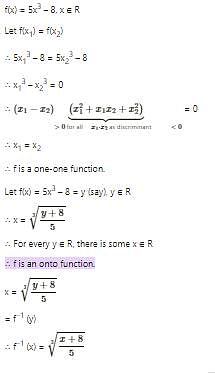SAT Exam > SAT Tests > Mathematics for Digital SAT > Test: Types of Functions - SAT MCQ
Test: Types of Functions - SAT MCQ
Test Description
10 Questions MCQ Test Mathematics for Digital SAT - Test: Types of Functions
Test: Types of Functions for SAT 2025 is part of Mathematics for Digital SAT preparation. The Test: Types of Functions questions and answers have been
prepared according to the SAT exam syllabus.The Test: Types of Functions MCQs are made for SAT 2025 Exam. Find important
definitions, questions, notes, meanings, examples, exercises, MCQs and online tests for Test: Types of Functions below.
Solutions of Test: Types of Functions questions in English are available as part of our Mathematics for Digital SAT for SAT & Test: Types of Functions solutions in
Hindi for Mathematics for Digital SAT course. Download more important topics, notes, lectures and mock
test series for SAT Exam by signing up for free. Attempt Test: Types of Functions | 10 questions in 15 minutes | Mock test for SAT preparation | Free important questions MCQ to study Mathematics for Digital SAT for SAT Exam | Download free PDF with solutions
Test: Types of Functions - Question 1
Let M = {5, 6, 7, 8} and N = {3, 4, 9, 10}. Which one of the following functions is neither one-one nor onto?
Detailed Solution for Test: Types of Functions - Question 1
Test: Types of Functions - Question 2
Let A = {1, 2, 3} and B = {4, 5, 6}. Which one of the following functions is bijective?
Detailed Solution for Test: Types of Functions - Question 2
Detailed Solution for Test: Types of Functions - Question 3
Test: Types of Functions - Question 4
A function f: R → R is defined by f(x) = 5x3 - 8. The type of function is _________
Detailed Solution for Test: Types of Functions - Question 4
Detailed Solution for Test: Types of Functions - Question 5
Test: Types of Functions - Question 6
Let P = {10, 20, 30} and Q = {5, 10, 15, 20}. Which one of the following functions is one – one and not onto?
Detailed Solution for Test: Types of Functions - Question 6
Test: Types of Functions - Question 7
A function f: R → R defined by f(x) = 5x4 + 2 is one – one but not onto.
Detailed Solution for Test: Types of Functions - Question 7
Test: Types of Functions - Question 8
The function f: R → R defined as f(x) = 7x + 4 is both one-one and onto.
Detailed Solution for Test: Types of Functions - Question 8
Test: Types of Functions - Question 9
A function f∶ N → N is defined by f(x) = x2 + 12. What is the type of function here?
Detailed Solution for Test: Types of Functions - Question 9
Detailed Solution for Test: Types of Functions - Question 10
|
185 videos|124 docs|75 tests
|
Information about Test: Types of Functions Page
In this test you can find the Exam questions for Test: Types of Functions solved & explained in the simplest way possible.
Besides giving Questions and answers for Test: Types of Functions, EduRev gives you an ample number of Online tests for practice







 Therefore, the function is onto.
Therefore, the function is onto.















